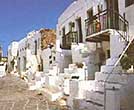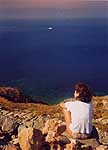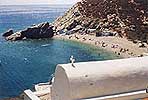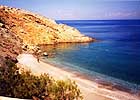The small Island of Folegandros (32 km² or just over 12 miles ²) is an untouched piece of true Greece. The 600 inhabitants of the island are mainly engaged in fishing. The island has become fashionable in recent years and the number of tourists has grown considerably. Although Folegandros has little in the way of tourist amenities or roads, visitors tend to "adapt" to the serene and relaxed way of living of the locals and get to know their quaint manners and customs. Walking around Folegandros is a joy as the environment, its perfumes, and its silence are really unique. In springtime and early summer the island is rich with caper flowers, thyme and oregano. The island is ideally suited to those who are in search of solitude and wish to be close to nature
 There are three main villages on the island Karavostasi, Hora (Folegandros town) and Ano Meria.
There are three main villages on the island Karavostasi, Hora (Folegandros town) and Ano Meria.
KARAVOSTASSIS. This small seaside settlement is situated 3 km (2 miles) southeast of Hora. The settlements' houses are white-washed and built in accordance with Cycladic architecture. Karavostassis is the island's port, where you will find fishing boats intermingled with and yachts at anchor. From Karavostassis, one should visit the areas of Petoussis and Livadi to admire the beautiful cave of Georgitsis.
 HORA (FOLEGANDROS).
Hora is one of the oldest traditional Medieval towns in the Cyclades, the buildings stand close to one
another creating the external wall of the castle (kastro).
The Hora, closed to car and motorcycle traffic, has a unique "centre" of three squares in a row,
with trees under which to enjoy a drink or a bite to eat in a quiet, romantic atmosphere.
It is no exaggeration to describe Hora as one of the most aesthetically picturesque, traditional villages of its kind,
150 meters (500 feet) above sea level, the view is said to be second only to that of Santorini.
HORA (FOLEGANDROS).
Hora is one of the oldest traditional Medieval towns in the Cyclades, the buildings stand close to one
another creating the external wall of the castle (kastro).
The Hora, closed to car and motorcycle traffic, has a unique "centre" of three squares in a row,
with trees under which to enjoy a drink or a bite to eat in a quiet, romantic atmosphere.
It is no exaggeration to describe Hora as one of the most aesthetically picturesque, traditional villages of its kind,
150 meters (500 feet) above sea level, the view is said to be second only to that of Santorini.
 The beautiful church of Panaghia , on the top of a hill, offers a nice walk and a magnificent view of Hora and of the west coast.
Other beautiful churches built within the castle, are Eleoussa, Pandanassa and Agia Sofia.
North and not far from Hora is Chrissospilia, it is the location of a stalactite cave with traces of ancient occupation,
the use of which is not yet known. In the cave, which is protected by the Archaeological Service,
smashed pots, shells, and human bones have been found.
The beautiful church of Panaghia , on the top of a hill, offers a nice walk and a magnificent view of Hora and of the west coast.
Other beautiful churches built within the castle, are Eleoussa, Pandanassa and Agia Sofia.
North and not far from Hora is Chrissospilia, it is the location of a stalactite cave with traces of ancient occupation,
the use of which is not yet known. In the cave, which is protected by the Archaeological Service,
smashed pots, shells, and human bones have been found.
ANO MERIA. The rural village of Ano Merià with it's typical "kafeneio" and taverns, is spread over cultivated fields with a myriad of dry stoned walls. Here you will find the Ecological and Folklore Museum of Folegandros with exhibits which reconstruct the farming practices of the island. It includes a rural residence with out buildings, an orchard and vineyard, utensils used in daily life, as well as local costumes.
Beaches
The island has a perimeter of 40 km. (25 miles) with a variety of beaches mostly quiet and reached by foot so take food and water.
 You can find some small beaches around the port area of Karavostasi. About 1 km from
Karavostasi you will find the beaches of Angali and Agios Nikolaos. You will also find
Livadi with it's beach and camping area.
You can find some small beaches around the port area of Karavostasi. About 1 km from
Karavostasi you will find the beaches of Angali and Agios Nikolaos. You will also find
Livadi with it's beach and camping area.
 From Ano Meria you may walk from 40 to 90 minutes to reach many
beaches, the finest being Agios Georgios, towards the northeast.
From Ano Meria you may walk from 40 to 90 minutes to reach many
beaches, the finest being Agios Georgios, towards the northeast.
From Hora a road stretches northwards, hugging the cliff-top and offering more breathtaking views before descending sharply to Vathi Bay where you can relax on a lovely, sandy beach.
